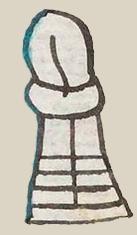maxtlatl (Mdz13r)
This element of a loincloth (maxtlatl) has been carved from the compound glyph for the place name Amaxtlan. It is white, probably cotton fabric, with a knotted loop and some horizontal lines of decoration at the ends hanging down. The small amounts of blue on the upper left edge of the loincloth are bits of paint that slopped over from the water sign that runs down the left side of the maxtlatl in the compound glyph.
Stephanie Wood
This loincloth (maxtlatl) would have been worn by a man, placed in front of his genitals. There would have been a waist band from which it would hang. The Florentine Codex provides examples of loincloths that hang both in front and in the back, covering part of the buttocks. See: Appendix, Book II, folio 110v. Sometimes only a loincloth was worn (when the climate was warm), and at other times, the loincloths were accompanied by a tunic or a sleeveless cape. This white maxtlatl is fairly plain compared to some of the loincloths in the iconographic examples of this collection. Differences in design probably related to social status--loincloths for the lower social strata were made from maguey fiber according to Henry B. Nicholson and Eloise Quiñones Keber in the Art of Aztec Mexico, 1983, p. 183--and perhaps also ethnicity and/or occupation. On some occasions, symbolic loincloths were carried in religious processions, such as those described by Kay Read, Time and Sacrifice in the Aztec Cosmos, 1998, p. 81, and Eloise Quiñones Keber in Representing Aztec Ritual, 2002, 124.
Stephanie Wood
c. 1541, but by 1553 at the latest
Stephanie Wood
loincloths, breechclouts, clothing, cloth, taparrabos, bragas, textiles, maxtlatl
This stone carving, a fragment of a masculine torso, shows a beautifully tied loincloth (maxtlatl), providing an excellent comparison for the glyph or element of a loincloth in this database. The museum signage also refers to the chalchihuitl necklace with a square pendant, and how the figure may have been a standard bearer. Photo by Rebecca Horn, 13 August 2023, taken at the Museo de Escultura Mexica in the archaeological site of Santa Cecelia Acatitlan (in the region of Tlalnepantla, Mexico City).

maxtla(tl), loincloth, https://nahuatl.wired-humanities.org/content/maxtlatl
loincloth
Mexico City
el taparrabos, la braga, el pareo
Stephanie Wood
Codex Mendoza, folio 13 recto, https://digital.bodleian.ox.ac.uk/objects/2fea788e-2aa2-4f08-b6d9-648c00..., image 36 of 188.
The Bodleian Libraries, University of Oxford, hold the original manuscript, the MS. Arch. Selden. A. 1. This image is published here under the UK Creative Commons, “Attribution-NonCommercial-ShareAlike 3.0 License” (CC-BY-NC-SA 3.0).



